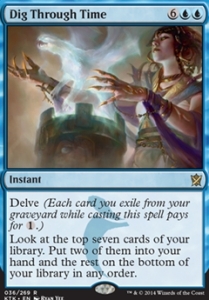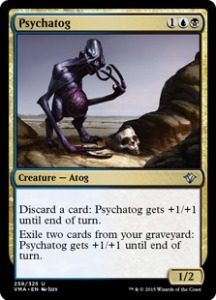 Links to the first two parts of my Tasigur analysis: Part 1, Part 2. As I stated in my first post, part of what makes Tasigur great is diplomatic play, and I mean great as in both “powerful” and “fun”. To be honest, he’s the best out of the BUG generals I’ve played – meaning all sans Sidisi herself, and I don’t see myself playing her ever, really. That said, there are times when the table is level, or maybe it’s clear that Tasigur is the one who’s behind, and in those cases, it might be difficult to forge alliances. Alliances are brokered between players of roughly equal strength in response to a third party’s perceived threat. Feel free to quote me on that. Recognising the problem, I decided to kill two creatures with one removal and add some cards that use my graveyard as a resource, meaning they were powered up by Tasigur’s activation and also restricting my opponents’ choices.
Links to the first two parts of my Tasigur analysis: Part 1, Part 2. As I stated in my first post, part of what makes Tasigur great is diplomatic play, and I mean great as in both “powerful” and “fun”. To be honest, he’s the best out of the BUG generals I’ve played – meaning all sans Sidisi herself, and I don’t see myself playing her ever, really. That said, there are times when the table is level, or maybe it’s clear that Tasigur is the one who’s behind, and in those cases, it might be difficult to forge alliances. Alliances are brokered between players of roughly equal strength in response to a third party’s perceived threat. Feel free to quote me on that. Recognising the problem, I decided to kill two creatures with one removal and add some cards that use my graveyard as a resource, meaning they were powered up by Tasigur’s activation and also restricting my opponents’ choices.
The Delve cards: Delve is an excellent ability, proven by Tombstalker in the past and Treasure Cruise in more recent times. In fact, the former almost made the list early on, an evasive beater with Delve is great, but in the end Tombstalker is just a 5/5, not very impressive by EDH standards. Without equipment to support him, he didn’t make the cut. These cards did, however:
1 Dig Through Time
1 Skeletal Scrying
1 Murderous Cut
1 Treasure Cruise
1 Necropolis Fiend
Technically, Skeletal Scrying isn’t a Delve card, but it is damn close, and it’s so powerful it truly belongs in the deck. In fact, I’d say it belongs in most black EDH decks period. Murderous Cut is dumb removal, but dumb removal can have its place in the format for diplomatic purposes (as I wrote about in part 2 of my analysis), it’s easy to cast with but a couple of dead cards in the graveyard, and its very non-restrictive. Dig Through Time and Treasure Cruise have both demonstrated their power in both Legacy and Modern, and are great cards in EDH as well. Finally, Necropolis Fiend, the younger and slimmer cousin of Tombstalker that’s just a wee bit higher maintenance makes the spot due to his ability to continuously exile chaff from the graveyard, and getting rid of a whole bunch when cast.
The other three stooges: Aside the Delve spells, these three cards also line up well with Tasigur’s ability to mill, and two of them are plain good cards that support a grindy control strategy well.
1 Psychatog
1 Snapcaster Mage
1 Eternal Witness
Psychatog tore a huge hole through all relevant constructed formats when he was printed in Odyssey and was hailed as “the best creature of all time” – a title he inherited from Morphling. He was printed in a cycle in Odyssey with five allied coloured Atogs, with two abilities each – and each ability tied to a colour. It just so happens that the blue one (discard a card) and the black one (exile two cards from your graveyard) went together much better than say the white (sacrifice an enchantment) and blue or the black or red (sacrifice a land) ever did, and the inherent synergy in the card created a monster.
Psychatog was for a long time a staple in even Vintage, and for this, Wizards has punished him thoroughly with the art change in his Vintage Masters “reprint”. Jeez. Psychatog is in Tasigur because he is awesome, I really liked casting him in Extended and Vintage back in the day, and he does what Necropolis Fiend does without requiring an investment of mana upon activation. Dr Teeth belongs in the deck. The other two stooges are merely good cards in the colours that helps Tasigur in the late game. Both are quite boring, but very strong.


Grim Lavamancer
/ May 7, 2015Dear lord, Psychatog, what have they done to you?
Also, regarding alliances, I believe Machiavelli wrote something similar in The Prince, about how you should only ally yourself with someone weaker than you to take out a stronger threat than yourself. If you ally with someone stronger than yourself to take out an even greater threat it would leave your ally the strongest person left, and he/her would inevitably turn against you. Dang, come to think about it, EDH is one of the most practical place to apply Machiavelli’s teachings in modern society…
LikeLike
purgatog
/ May 18, 2015Problems arise when everyone follows that rule, however, at least as long as everyone is correctly perceiving their strength. There would be no alliances! 😦
LikeLike